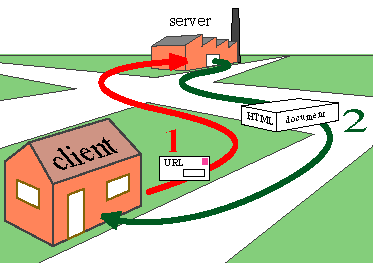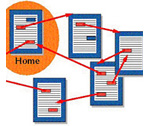How the web works
The Web is a world of information available at the click of a mouse. To use it, you need a computer, a connection to the Internet, and a browser.
When you run your browser, it finds and displays pages of information. The function of a Web browser is to interpret the programming language of the web pages (HTML, …) and transform it into the words and graphics that you see on your screen. If you need more information, all you have to do is click on a hyperlink. On each page, certain words, phrases, or even images are highlighted, and clicking on them causes the browser to go off and find another page, which probably contains more highlighted items, and so on.
 All Web documents are stored on so-called server computers, represented in the image by a factory. Users can inspect these documents by requesting them from their local (personal) computers, represented by the house, and called a client.
All Web documents are stored on so-called server computers, represented in the image by a factory. Users can inspect these documents by requesting them from their local (personal) computers, represented by the house, and called a client.
 All computers involved in the Web are connected by the Internet, represented by the roads. When you click on a hyperlink, your computer asks a server computer to return to you a document.
All computers involved in the Web are connected by the Internet, represented by the roads. When you click on a hyperlink, your computer asks a server computer to return to you a document.
For example, starting from the CERN ‘Welcome page’ in Switzerland your next click might fetch a document from a physics lab at the other side of the world. All the information seems to be in the little box in front of you, though in reality it is spread over the globe.
The web is also friendly to the network: when you click on a piece of highlighted text your browser ‘orders a document’ from another computer, receives it by ‘return mail’ and displays it. You are then free to read the new page at leisure, without further consumption of network resources.
The Web may be used to initiate processes on either the client or the server. A request can start a database search on a server, returning a synthesised document. A document returned in an unfamiliar format can cause the browser to start a process on the client machine in order to interpret it.
The Web's ability to negotiate formats between client and server makes it possible to ship any type of document from a server to a client, provided the client has the appropriate software to handle that format. This makes video, sound and anything else accessible without the need for a single application to be able to interpret everything.
The Web and the Internet
The Web is not identical to the Internet; it is only one of the many Internet-based communication services. The relation between them may be understood by using the analogy with the global road system. On the Internet, as in the road system, three elements are essential: the physical connections (roads and cables), the common behaviour (circulation rules and Internet protocol) and the services (mail delivery and the WWW).
The physical connections: cables and roads
Cables are a passive infrastructure, laid down locally by governments and telecoms companies. Cables have different capacity: a single telephone line like the one leading from your home can handle about 7 kilobytes per second, the equivalent of a page of text per second. Optical fibres handle well into the thousand millions of bytes per second. Although the cables may be of different types and the junctions may be very complicated, they are all interconnected.
On the roads it is possible for you to drive from home out to a far away place, perhaps in another country, passing from highways to country roads. Similarly, you can find a continuous connection through several interchange nodes between your computer at home and the one of a friend in Australia.
The common behaviour: the Internet
Connecting computers to the cables is not enough: to be able to talk to each other they have to agree on a common way of behaving, just like we do when we drive our cars on the roads. The Internet is like the traffic rules: computers must use the cables in an agreed fashion.
Thousands of cars can use the same roads even if they all have different destinations; no problems arise as long as on the road everybody drives on one side, stop for red traffic lights and so on.
The Internet transfers data in little packets between computers. To use the cables between them profitably, computers must obey rules too: they have to use the same communication protocol.
A communication protocol is something you are familiar with if you have ever talked to someone: in a conversation, people know when to start speaking, when to stop, which sounds to make to encourage the other person to continue, and so on. This is an implicit ‘protocol’ for humans. Computers exchanging data over cables need a similar set of rules for behaviour.
To be ‘connected to the Internet’, a computer must respect the Internet protocols. It can do so if a compatible layer of software has been installed on it. The common protocol for the Internet is called the Transmission Control Protocol/Internet Protocol or TCP/IP.
Services for everyone
Once you have the cables and the protocol to use them, your computer can communicate with all the others. But what can they say to each other?
You can use the roads to drive on as an individual, you can run scheduled bus lines, transport heavy goods, you can even run a pizza delivery service. Similarly, on the Internet, you can run data services: electronic mail, file transfer, remote log-in, bulletin boards, …
The World Wide Web is just one of them, a bit like a ‘parcel delivery service’: at your request, the WWW will deliver you the required document.

